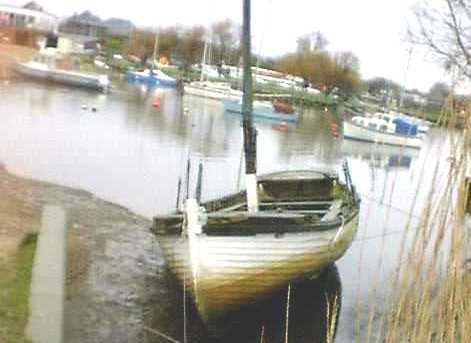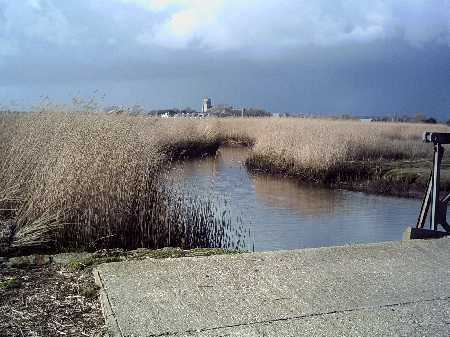Hengistbury Head in the 18th Century
After the demise of Yarrantons 17th century schemes for the development of Christchurch Harbour, the area reverted to being a small anonymous fishing port and Hengistbury Head (or Heads) no doubt, reverted to a desolate piece of marginal grazing land. However in 1733 The Walpole government passed the Excise and Customs Bill. This severely restricted the import of a whole range of items into the country, and imposed punitive levies on items such as brandy, wine, silk and lace. While supply was heavily constrained by the import levies,massive amounts of money could be made by running the Channel to Cherbourg and bringing back the contraband goods. The local fishing and farming fraternity (and just abou everyone else for that matter!) took to smuggling or aiding and abetting the smugglers like ducks to water.The smugglers became known locally as Free Traders although in reality they were arguably the forbears of modern organised crime.
Notorious smugglers became local heros. Hanna Sillar (the so-called Angel of the Marsh) ran the "Ship In Distress" Inn in Stanpit and was a prime ringleader. Much contraband was shipped into her premises by the local smugglers. Her next door neighbour was Charles Streeter. He became a local gang master and Tobacco baron

A few years ago this derelict was laid up near Wick slipway. She bore all the hallmarks as being a descendant of the original Mudeford cutters as used by the smugglers in the 18th and 19th centuries. She was 32ft long with 8 ft beam and 5 ft stern. With traditional Clinker built construction she was a fast open sailing boat. She was well past saving although the quality of her construction still shone though. She was probably built late 19th/early 20th century, possibly for the new sport of yacht racing practiced by the wealthy (and guided by the local sea-farers). She was probably the last of her line. I believe she became a safety hazard and was broken up.
In the Christchurch area the local fishing and trading boats,were pressed into smuggling service. These were locally designed small fast open boats. They could easily outrun the standard coastguardvessels and often would sail in weather which would leave the coastguard boats and ships firmly riding at anchor in a sheltered bay. Against the skilled local sailors in their Mudeford Cutters, the Customs men came a poor second.
Hengistbury Head, due to its anonymous and remote location played a central part in this smuggling. Bizarrely the ancient defensive rampart, the Double Dykes, were put to use by the smugglers as they provided almost perfect cover for trains of wagons used to take away the casks of Brandy and wine. A great deal of contraband was landed either off the seaward side of the head or brought up through the Run and landed off at the Wickhams or through Mother Sillers Channel in Stanpit Marsh.

The view today down Mother Sillars Channel. In the 18th century tons of contraband were smuggled along this channel to the "Ship In Distress" Public House.
The contraband landed off the Wickhams or off the seaward side of the Head was generally then taken by cart up through what is now Bournemouth and offloaded of various farms, taverns and private houses as the entourage went by. The contraband offloaded at Mother Sillers channel usually made its way to the Ship In Distress at Mudeford. Mother Sillers channel is named after one the landladies of The Ship in Distress, namely one Hanna Siller, a notorious smuggler-in-chief who also, at the time of the "Battle of Mudeford" (see later) ran the original Haven House tavern on Mudeford.
Smuggling was to continue off Hengistbury head until the mid 1850's. The most dramatic event of these times occurred in 1784 when the so called Battle of Mudeford took place. This involved the planned interception of a smuggler off Hengistbury Head (or Christchurch Point as the contemporary description describes it). The smugglers where evidently under the command of "Slippery Rogers", the grandson of the former Mayor of Christchurch.
Long boats were being unloaded on the beach as the coast guard cutter arrived on the scene, a battle ensued that cost the life of one of the coast guards. As a result many smugglers were driven into hiding or fled abroad. One smuggler was hanged for the murder of the coast guard although it is highly unlikely that the individual executed fired the fatal shot.
During this period, as the smuggling continued apace, a scheme emulating and exceeding Yarrantons original 17th century ideas were put forward. In 1762, John Smeaton ( who incidentally designed the first practical and durable lighthouse) placed proposals forward to enhance Christchurch harbour and aid navigation from Christchurch to Salisbury via the river Avon. He favoured a cut through Mudeford Spit, as had Yarranton. Smeaton though, understood the nature of long shore drift and laid plans to build the southern jetty before the northern one and also to ensure that length of the Southern jetty was much greater than that of the northern one. Smeaton planned to use the iron stone doggers from the head and to supplement these with cheap low quality stone from Portland. Had Smeatons scheme gone ahead then it is likely that the catastrophic damage done by ironstone removal, in the 1850's, would have been pre-empted by Smeaton. The extra one hundred years of heavy erosion would have probably spelt extinction for the head. The whole of the coastline between the Old Harry Rocks and Hurst Castle would now be dramatically different. Smeaton estimated the cost the engineering works at about £6000. Whether the financial cost was deemed too high is unknown but, for whatever reason, Smeatons plans were abandoned.